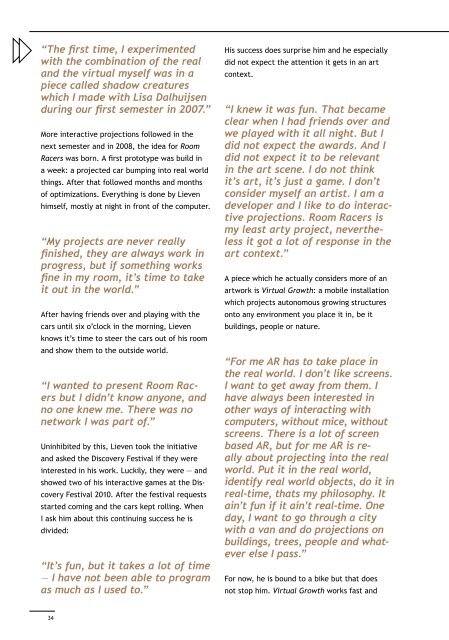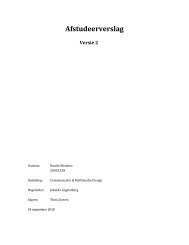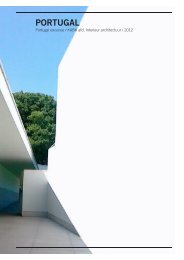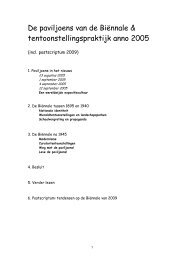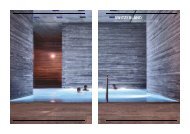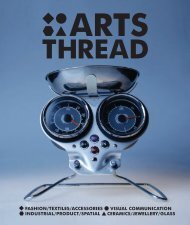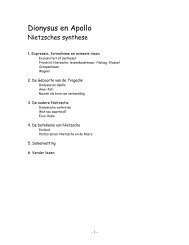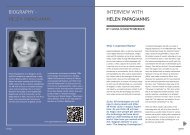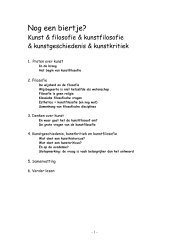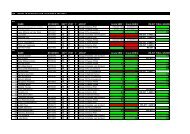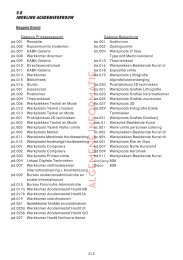download LR pdf - Kabk
download LR pdf - Kabk
download LR pdf - Kabk
You also want an ePaper? Increase the reach of your titles
YUMPU automatically turns print PDFs into web optimized ePapers that Google loves.
“The first time, I experimentedwith the combination of the realand the virtual myself was in apiece called shadow creatureswhich I made with Lisa Dalhuijsenduring our first semester in 2007.”More interactive projections followed in thenext semester and in 2008, the idea for RoomRacers was born. A first prototype was build ina week: a projected car bumping into real worldthings. After that followed months and monthsof optimizations. Everything is done by Lievenhimself, mostly at night in front of the computer.“My projects are never reallyfinished, they are always work inprogress, but if something worksfine in my room, it’s time to takeit out in the world.”After having friends over and playing with thecars until six o’clock in the morning, Lievenknows it’s time to steer the cars out of his roomand show them to the outside world.“I wanted to present Room Racersbut I didn’t know anyone, andno one knew me. There was nonetwork I was part of.”Uninhibited by this, Lieven took the initiativeand asked the Discovery Festival if they wereinterested in his work. Luckily, they were — andshowed two of his interactive games at the DiscoveryFestival 2010. After the festival requestsstarted coming and the cars kept rolling. WhenI ask him about this continuing success he isdivided:“It’s fun, but it takes a lot of time— I have not been able to programas much as I used to.”His success does surprise him and he especiallydid not expect the attention it gets in an artcontext.“I knew it was fun. That becameclear when I had friends over andwe played with it all night. But Idid not expect the awards. And Idid not expect it to be relevantin the art scene. I do not thinkit’s art, it’s just a game. I don’tconsider myself an artist. I am adeveloper and I like to do interactiveprojections. Room Racers ismy least arty project, neverthelessit got a lot of response in theart context.”A piece which he actually considers more of anartwork is Virtual Growth: a mobile installationwhich projects autonomous growing structuresonto any environment you place it in, be itbuildings, people or nature.“For me AR has to take place inthe real world. I don’t like screens.I want to get away from them. Ihave always been interested inother ways of interacting withcomputers, without mice, withoutscreens. There is a lot of screenbased AR, but for me AR is reallyabout projecting into the realworld. Put it in the real world,identify real world objects, do it inreal-time, thats my philosophy. Itain’t fun if it ain’t real-time. Oneday, I want to go through a citywith a van and do projections onbuildings, trees, people and whateverelse I pass.”For now, he is bound to a bike but that doesnot stop him. Virtual Growth works fast andstable, even on a bike. That has been witnessedin Amsterdam, where the audiovisual bicycleproject ‘Volle Band’ put beamers on bikes andinvented Lieven to augmented the city with hismobile installation. People who experiencedVirtual Growth on his journeys around Amsterdam,at festivals and parties, are enthusiasticabout his (‘smashing!’) entertainment-art. As thevirtual structure grows, the audience membersnot only start to interact with the piece but alsowith each other.“They put themselves in frontof the projector, have it projectingonto themselves and pass onthe projection to other peopleby touching them. I don’t explainanything. I believe in simpleideas, not complicated concepts.The piece has to speak for itself.If people try it, immediately getit, enjoy it and tell other peopleabout it, it works!”Virtual Growth works, that becomes clear fromthe many happy smiling faces the projectiongrows upon. And that’s also what counts forLieven.“At first it was hard, I didn’t getpaid for doing these projects. Butwhen people see them and are enthusiastic,that makes me happy.If I see people enjoying my work,and playing with it, that’s whatreally counts.”I wonder where he gets the energy to work thatmuch alongside being a student. He tells me,what drives him, is that he enjoys it. He likes tospend the evenings with the programming languageC#. But the fact that he enjoys working onhis ideas, does not only keep him motivated butalso has caused him to postpone a few coursesat university. While talking, he smokes hiscigarette and takes the ashtray from the floor.With the road no longer blocked by it, the carstake a different route now. Lieven might take adifferent route soon as well. I ask him, if he willstill be working from his living room, realizinghis own ideas, once he has graduated.“It’s actually funny. It all startedto fill my portfolio in order to geta cool job. I wanted to have somethings to show besides a diploma.That’s why I started realizing myideas. It got out of control andsoon I was realizing one idea afterthe other. And maybe, I’ll justcontinue doing it. But also, thereare quite some companies andjobs I’d enjoy working for. FirstI have to graduate anyway.”If I have learned anything about Lieven and hiswork, I am sure his graduation project will beplaced in the real world and work in in realtime.More than that, it will be fun. It ain’tLieven, if it ain’t’ fun.Name:lieven van VelthovenBorn: 1984Study:media Technology MSc,Leiden UniversityBackground: Computer Science,TU DelftSelected AR Works: Room Racers,Virtual GrowthWatch:http://www.youtube.com/user/lievenvv34 35


